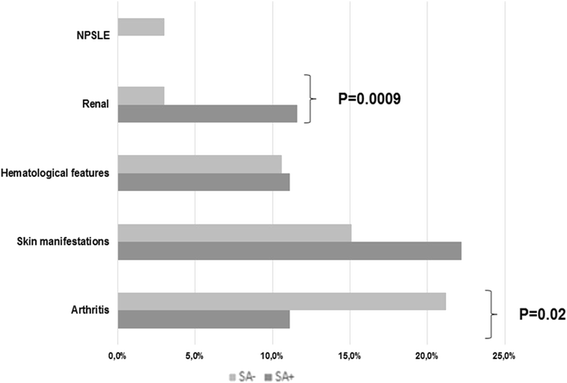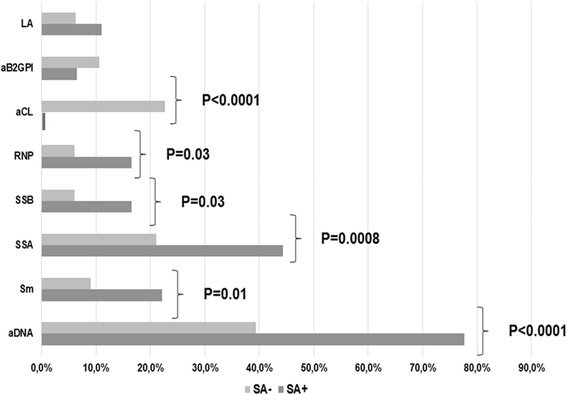Association between Staphylococcus aureus nasal carriage and disease phenotype in patients affected by systemic lupus erythematosus
- PMID: 27475749
- PMCID: PMC4967505
- DOI: 10.1186/s13075-016-1079-x
Association between Staphylococcus aureus nasal carriage and disease phenotype in patients affected by systemic lupus erythematosus
Abstract
Background: Staphylococcus aureus (SA) is a commensal bacterium representing one of the most important components of the skin microbiome, mostly isolated in the anterior nares. A higher rate of SA nasal colonization in patients affected by Wegener's granulomatosis and rheumatoid arthritis compared with healthy subjects (HS) has been described. No studies focusing on systemic lupus erythematosus (SLE) are available. We aimed at analyzing the prevalence of SA nasal carriers in an SLE cohort and evaluating correlation between nasal colonization and clinical, laboratory and therapeutic features.
Methods: We enrolled 84 patients with SLE (number of male/female patients 6/78; mean age 41.3 ± 12.2 years, mean disease duration 142.1 ± 103.8 months) and 154 HS blood donors. Patients with SLE underwent a physical examination and the clinical/laboratory data were collected. All the patients with SLE and the HS received a nasal swab for SA isolation and identification.
Results: SA nasal colonization prevalence was 21.4 % in patients with SLE and 28.6 % in HS (P not significant). We analyzed patients with SLE according to the presence (n = 18, SA-positive SLE) or the absence (n = 66, SA-negative SLE) of nasal colonization. Renal involvement was significantly more frequent in SA-positive SLE (11.6 % vs 3.0 %; P = 0.0009). Moreover, the presence of anti-dsDNA, anti-Sm, anti-SSA, anti-SSB, anti-RNP antibodies was significantly higher in SA-positive SLE (P < 0.0001, P = 0.01, P = 0.008, P = 0.03, P = 0.03, respectively).
Conclusion: SA colonization is a relatively frequent condition in patients with SLE, with a frequency similar to HS. The presence of SA seems associated with a peculiar SLE phenotype characterized by renal manifestations and autoantibody positivity, confirming the role of the microbiome in disease phenotype.
Keywords: Microbiome; Staphylococcus aureus; Systemic lupus erythematosus.
Figures


References
-
- den Heijer CD, van Bijnen EM, Paget WJ, Pringle M, Goossens H, Bruggeman CA, APRES Study Team et al. Prevalence and resistance of commensal Staphylococcus aureus, including meticillin-resistant S aureus, in nine European countries: a cross-sectional study. Lancet Infect Dis. 2013;13:409–415. doi: 10.1016/S1473-3099(13)70036-7. - DOI - PubMed
MeSH terms
Substances
LinkOut - more resources
Full Text Sources
Other Literature Sources
Medical
Research Materials

